DS+R, FXCollaborative, REX, SHoP, WORKac, and Studio Gang lead group of 2023 AIANY Design Awards winners
By Josh Niland|
Wednesday, Jan 11, 2023
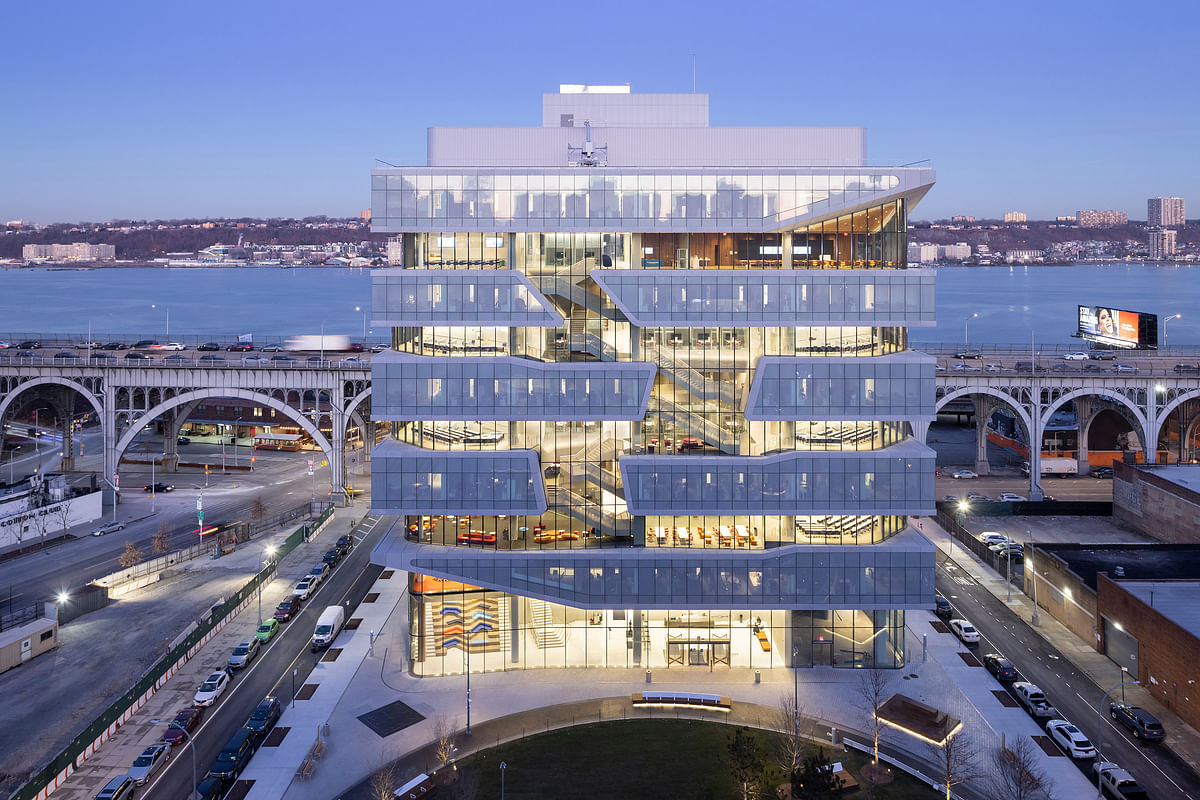
Related
The AIA New York chapter has announced its annual list of Design Awards winners, representing the best designs taken from the city's firms in the form of 18 total projects spread throughout the region, country, and world.
Winners were awarded in four categories: Architecture, Interiors, Projects, and Urban Design. Among this year's honorees were Diller Scofidio + Renfro and FXCollaborative's new business school for Columbia University in Harlem, the latest Studio Gang residential tower in Dumbo, Brooklyn, and Marvel's makeover of the Battery Maritime Building for Casa Cipriani.
The 2023 jury was made up of JLL Vice President Ronnie Belizaire; Chicago Department of Transportation Commissioner Gia Biagi; RMA Principal Nondita Correa Mehrotra; Associate Principalat Leers Weinzapfel Associates, Ashley Rao; and Angela Brooks, Managing Principal of Brooks + Scarpa.
Each project will be honored at the AIANY Honors and Awards Luncheon on Thursday, April 20th. Winners will also be featured in the AIANY Design Awards 2023 exhibition, which will be on view from May 4th through September 2nd at the Center for Architecture in Manhattan.
ARCHITECTURE CATEGORY:
Honor Winners
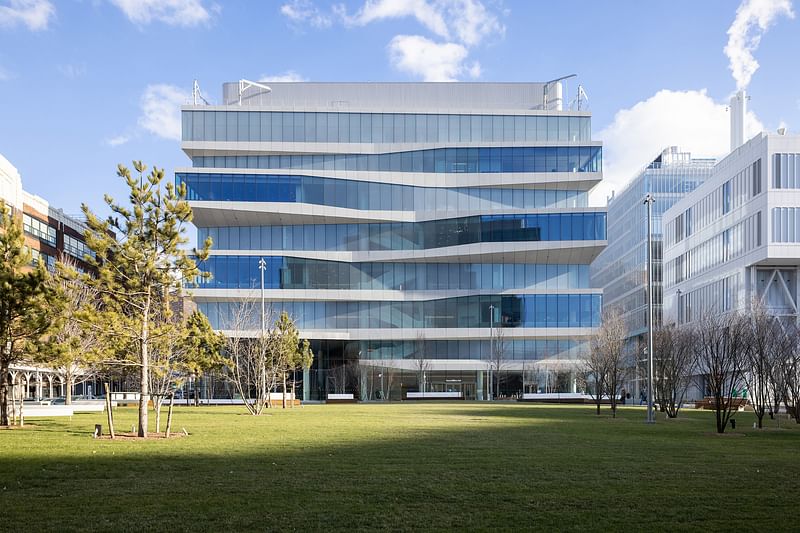
Columbia Business School Henry R. Kravis Hall and David Geffen Hall in New York, NY
Architect: Diller Scofidio + Renfro, FXCollaborative
Associate Architect: AARIS Design Architects
Jury citation: "Columbia Business School’s new home spans 492,000 square feet across two buildings that doubled the school’s existing square footage. The innovative design inverts the typical organization of building populations, shuffling alternating floors of faculty and administrative offices with student learning spaces in both the 11-story Kravis R. Hall and the eight-story David Geffen Hall, fostering a community where students, faculty, alumni, and practitioners can gather to exchange ideas. Intersecting vertical networks of circulation and collaborative learning environments link spaces of teaching, socializing, and studying to create a continuous space of learning and interaction that remains vibrant 24 hours a day. The design recognizes that creativity, innovation, and communication—skills often nurtured in informal environments—are as crucial to business school pedagogy as the traditional, quantitative skills taught in a classroom. The new design emphasizes engagement with the city: every classroom provides a view to the surrounding West Harlem neighborhood, or the adjacent Riverside Drive Viaduct and Hudson River. Kravis Hall offers retail at ground level, which can be used for community programming, and an urban–scale living room for students, faculty and staff, while Geffen Hall features a cafe and terraced interior landscape that doubles as a 300–seat lecture hall."
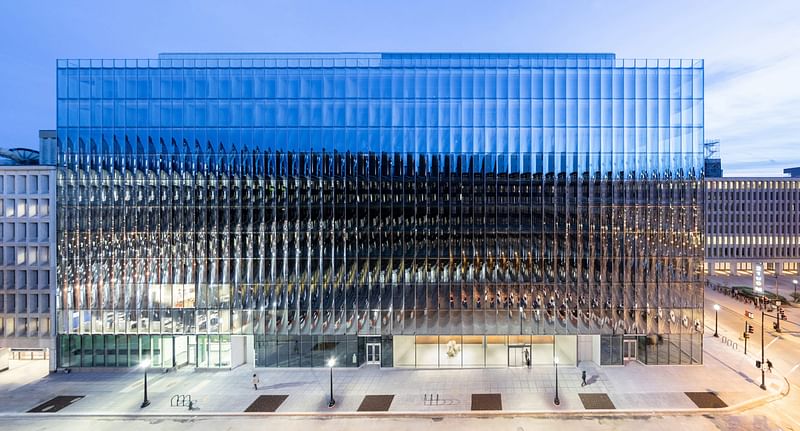
2050 M Street in Washington, DC
Architect: REX Architecture
Architect of Record: Kendall/Heaton Associates
Jury citation: "2050 M Street is a Class A spec office building in Washington, DC conceived to set a new standard in its market. Adhering to DC’s strict zoning on building height and massing that limits architectural uniqueness, 2050 M Street leverages its façade to create a memorable identity and provide the leasing ideal of hyper-transparent, floor-to-ceiling glass without view-impeding mullions. The façade’s insulated-glass panels are curved with geometric precision and no distortion using a bending tempering furnace. The inherent rigidity of the curved glass eliminates the need for structural mullions (leaving only a minimalist unitized frame improving sightlines and increasing usable floor area) and reduces the thickness of the monolithic outer lite (providing greater transparency). To emphasize the skin’s lightness, perimeter columns are pulled off the façade and the ceiling’s edge tapered to the depth of the pre-tensioned structural slab. An exterior, reflective pyrolytic coating and a low-E coating within the glass’ insulating cavity pair with the panels’ fluting to create a kaleidoscopic effect that simultaneously animates the city, dematerializes the façade, and creates the edifice’s distinctive image. In contrast to the building’s pristine exterior, the lobby harbors the rich, warm tones and materiality of sapele mahogany and Bella Rosa onyx."

Uber Headquarters in San Francisco, CA
Architect: SHoP Architects
Architect of Record: Quezada Architecture
Jury citation: "In addition to supporting responsible development by locating it in the city near public transportation, the project’s key goal is to bring this developing area into step with the successful, human-scaled environments for which San Francisco is so famous. The 453,000-square-foot project includes an eleven-story tower at 1455 Third Street and a six-story structure at 1515 Third Street, each with active facades that are part of a comprehensive approach to sustainability."
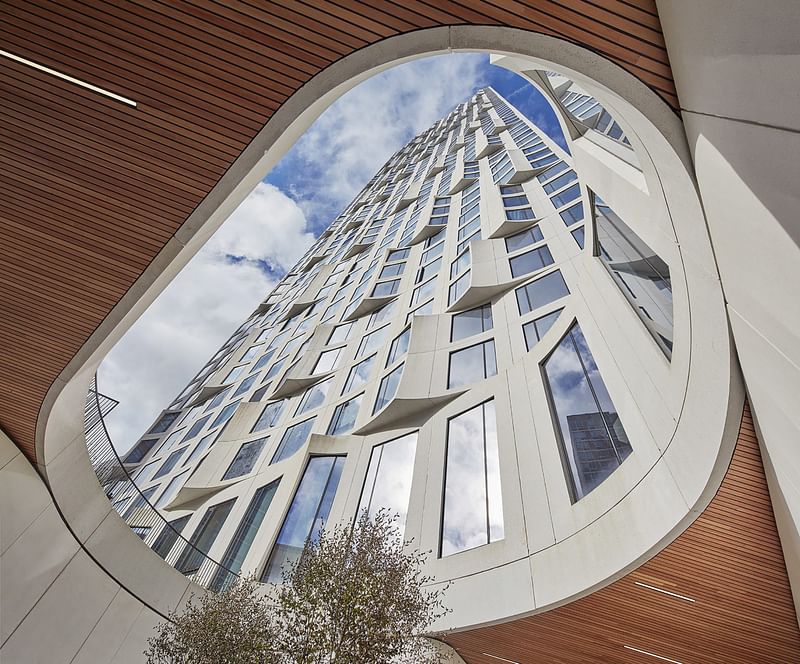
11 Hoyt in Brooklyn, NY
Architect: Studio Gang
Architect of Record: Hill West Architects
Landscape Architect: Hollander Design Landscape Architects
Jury citation: "A new condominium tower, 11 Hoyt provides space for nature and community to thrive, vertically, within the densifying neighborhood of Downtown Brooklyn. 11 Hoyt transforms its full-block site, formerly a parking garage, into an elevated green podium anchored by a tower with scalloped edges rising above it. Visible from the street yet buffered from its activity, the podium’s indoor-outdoor environment acts as the “fifth facade” of the building, increasing its sustainability while encouraging neighbors to meet among trees, gardens, and other amenities. Connections between inside and outside are furthered by the tower’s thickened, inhabitable facade. The building pushes out in plan to create expanded living spaces with built-in window seats, maximizing views of the neighborhood and offering glimpses of the building’s sculptural exterior. Migrating across the facade like the cusps of a wave, the scallops create more than 190 unique floor plans that accommodate a diverse mix of residents."

Marea in Batroun, Lebanon
Architect: WORKac
Jury citation: "At Marea, architecture approaches landscape and landscape approaches architecture. Located outside the ancient city of Batroun, 50 kilometers up the Lebanese coast from Beirut, the development consists of 60 units arranged into four terraced rows and was previously a Syrian army camp inaccessible to civilians. Stepping up from the sea, private beachfront houses are followed by a diversity of smaller dwellings—semi-detached houses, townhouses, and condominiums. The villas are set into a complex geography of triangulated folds which continues across materials and surfaces. The villas’ folded green roofs become an extension of this landscape, an undulating topography that descends to the sea. A network of stepped footpaths weaves around the blocks of villas, as in a hill town—while vehicular circulation is relegated to an underground network of parking spaces, accessed from the top of the site. Despite the site’s density, units have substantial privacy and amenities, with double-height living spaces, patios, and private swimming pools. Even the smallest condos have a patio or roof deck. Residents share access to a common clubhouse on the beach."
Merit Winners
One South First in Brooklyn, NY
Architects: COOKFOX, dencityworks, SHoP Architects, and James Corner Field Operations
Princeton University Residential Colleges in Princeton, NJ
Architects: Deborah Berke Partners and James Corner Field Operations
TheatreSquared in Fayetteville, AR
Architect: Marvel
John Lewis Elementary School in Washington, DC
Architect: Perkins Eastman
The Hood Museum of Art in Hanover, NH
Architect: Tod Williams Billie Tsien Architects (with Hargreaves Jones)
Citation for Navigating the Balance Between Preservation and Activation
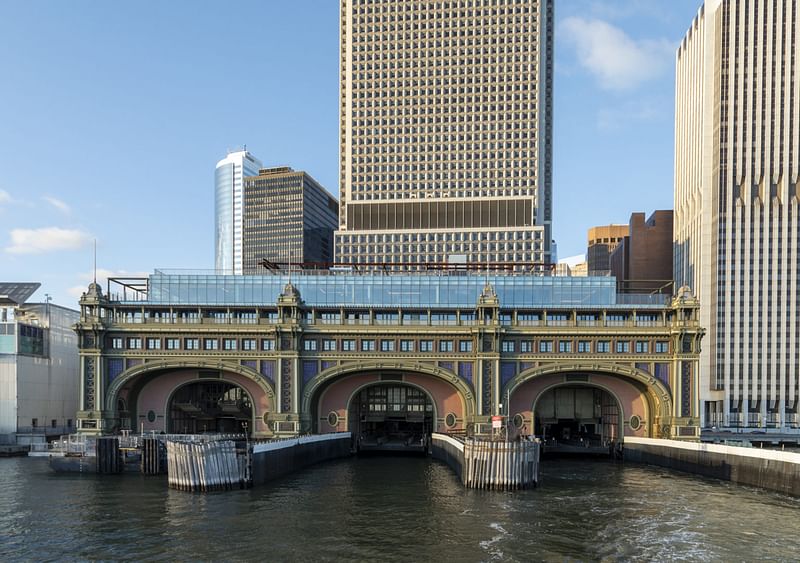
Battery Maritime Building – Casa Cipriani in New York, NY
Architect: Marvel
Preservation Consultant: Higgins Quasebarth & Partners
Jury citation: "The Battery Maritime Building, a 1909 historic ferry terminal at the southern tip of Manhattan, was once the crown jewel of the New York City waterfront. After years of neglect, the structure was at risk of being lost forever. As lead architect, our team performed the adaptive reuse redevelopment project, crafting an elegantly modern and historically sensitive conversion into a multi-use event and hospitality venue. Today the 162,000-square-foot facility is fully reactivated. The ground floor still provides ferry operations, a porte-cochere driveway, and two gracious new lobbies with a ceremonial grand stair. The civic second floor is fully rehabilitated as an events venue centered about the dramatically restored Great Hall. The third and fourth floors were completely rebuilt as a boutique hotel. Finally, a fifth-floor modern glass addition houses a membership club with a jazz lounge, bars, and a restaurant with sweeping views of the upper Hudson Bay. This project saved an important New York City landmark and National Register Building for the foreseeable future, completing the full preservation, rehabilitation, and reconstruction, while revitalizing the waterfront."
INTERIORS CATEGORY
Honor Winners

RELATED NEWS Two emerging architects awarded AIANY's 2022 Stewardson Keefe LeBrun Travel Grant
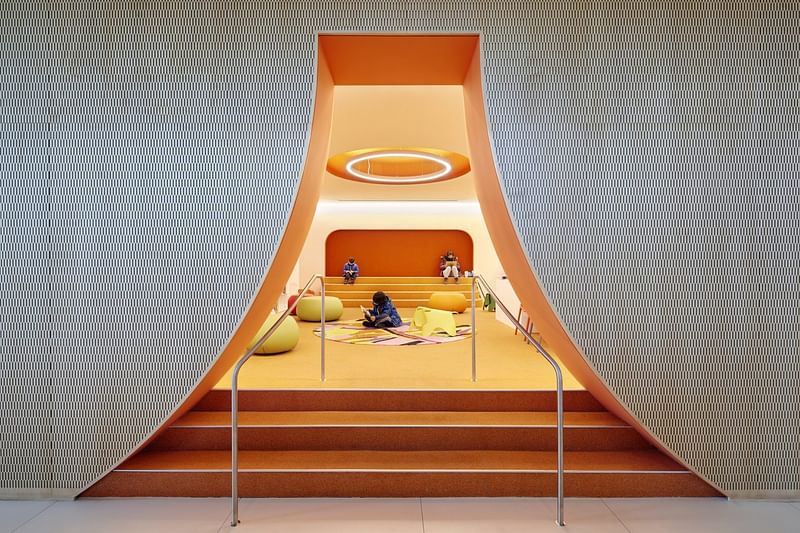
Brooklyn Public Library Adams Street Branch in Brooklyn, NY
Architect: WORKac
Jury citation: "The new Adams Street Library is Brooklyn Public Library’s first new branch to open in more than 20 years. Extensive, architect-led community outreach within Dumbo, Vinegar Hill and the Farragut Houses indicated that children’s spaces and programming was lacking—and important to residents across the diverse neighborhoods. The design therefore puts children at its center, containing spaces for learning activities, story time, books, reading and views out to Brooklyn Bridge Park. The library also has new collections, technology and extensive programming for teens and young adults in a dedicated teens area. Two large, flexible multipurpose spaces with stackable chairs and foldable tables, whiteboards and a kitchenette provide much-needed space for community gathering and meeting. Technology is readily accessible to patrons with free Wi-Fi throughout, hard-wired charging and power built into the reading tables and projection capability in the large community room. The library also has generous spaces for staff and public, gender-inclusive restrooms."
Merit Winner
Permanent Mission to the United Arab Emirates to the United Nations in New York, NY
Architect: Skidmore, Owings & Merrill
Citation for Innovative Use of Curved CLT to Encourage Fluid Movement
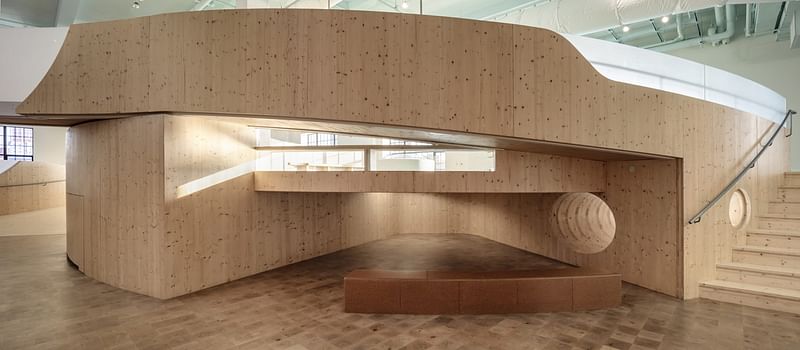
Bronx Children’s Museum in The Bronx, NY
Architect: O'Neill McVoy Architects
Jury citation: "The Bronx Children's Museum engages children with urban culture and the natural world. The design catalyzes the site’s position between the city grid and tidal river with an architecture of organic flow inside the rectangular frame of a 1925 historic powerhouse. The design is inspired by Jean Piaget’s Child’s Conception of Space. Before learning Euclidean space, a child starts building up relationships such as proximity and separation, order and enclosure, continuity and openness. The design’s spatial flow creates a new kind of space, unlike the city’s cellular rooms and street grids, that connects kids to the experience of natural landscape and the waterfront. The Museum features interactive exhibits where families can play, learn, and connect to the natural and cultural resources in the Bronx through art, dramatic role-play and scientific exploration. The Museum is entered via a ground floor double-height lobby facing the Harlem River. Once on the second-floor visitors are greeted with a tall, light-filled open space with views to the river and city. Walls, guardrails, doors, stairs, and floors are made of cross-laminated timber, fabricated with advanced digital technology allowing for varying radii arcs to form organic space, the first use of curved CLT in the U.S."
PROJECTS CATEGORY
Merit Winner
Battery Playscape in New York, NY
Architects: BKSK Architects and Starr Whitehouse
Citation for Provoking Questions on Ownership of the Public Way

Librería Barco de Papel in Queens, NY
Architect: N H D M
Jury citation: "Barco de Papel Libreria Y Centro Cultural is the only Spanish language literature bookstore currently surviving in New York City and a small but critical cultural center for researchers and lovers of Latin American culture. Located in Elmhurst, Queens, in the most culturally diverse zip code of the USA, for nearly 20 years, the humble bookstore served as a vibrant and resilient meeting place for artists, poets, and writers, as well as many immigrant and diaspora residents in the neighborhood. The renovation, scheduled for 2023, enhances the spaces for this important institution, improving access for the public, spaces for community activities, streetfront presence with alternations to the facade, interior, and the addition of new mobile elements. The operable facade windows fold out and open up Barco, transforming the intimate space into an outdoor public area for events and other expanded operations of the bookstore and cultural center. New operable furniture include a mobile horizontal book case / table that allows for a permeable facade and longer-term engagement with the book material and facilitate conversations and workshops. The project also utilizes various street-related initiatives implemented through the pandemic."
URBAN DESIGN CATEGORY
Honor Winner

New York City Housing Authority Open Space Master Plan in New York, NY
Landscape Architect: Grain Collective
Jury Citation: "New York City Housing Authority (NYCHA) is the largest housing authority in the country and New York City’s largest landlord. With over 500,000 tenants spread across 170,000 units, 1 in 15 New Yorkers call NYCHA campuses home. NYCHA is an urban landbank of over 2400 acres, yet 88% of open space sits behind fences and is inaccessible for resident use. 40% of the city’s playgrounds are housed on NYCHA campuses but go mostly untouched because of damage incurred by unintended adult use. But when considering nearly 75% of NYCHA residents are over 18, but only 2% of available outdoor space on campuses is designed for adult passive use, it’s clear something isn’t adding up. NYCHA’s Open Space Master Plan offers a new vision for a new era of public housing in New York, centered on resident quality of life. Grounded in active design principles, connected community-building, and multigenerational use, open space is the heart of the NYCHA Masterplan—a roadmap to removing fences, returning access to mature trees, and un-paving the way towards a greener future for NYCHA and all of NYC."
Citation for Achieving a New Level of Expression for Public Space

550 Madison Garden in New York, NY
Architect, Landscape Architect: Snøhetta
Architect of Record: Adamson Associates
Landscape Architect of Record: SiteWorks
Jury citation: "The 550 Madison Garden re-envisions the building’s public space as a generously expanded, densely vegetated garden. As a vibrant sensory retreat, its transformation draws upon the architectural heritage, the activity of the neighborhood, and the natural history of the region, offering the only publicly-accessible vegetated open space in the East Midtown District. As a privately-owned public space (POPS) that invites people to slow down, linger, and connect to one another and their surroundings, 550 Madison’s new garden embraces the powerful contemporary role POPS can play within the context of New York’s ever-changing urban fabric. The Garden is developed as part of a holistic overhaul of the 550 Madison tower undertaken by our design and client team. This transformation repositions the tower for multi-tenant use through respectful adaptive reuse. The Garden is organized as a collection of six outdoor rooms, each with a distinctive social ambiance. Designed around expansive, layered views of the buildings and spaces, the Garden’s rooms provide places where the people of Midtown can stop, rest, and reconnect with one another and their surroundings."

RELATED NEWS Thirty-two projects win in 2018 AIANY Design Awards


Share
0 Comments
Comment as :